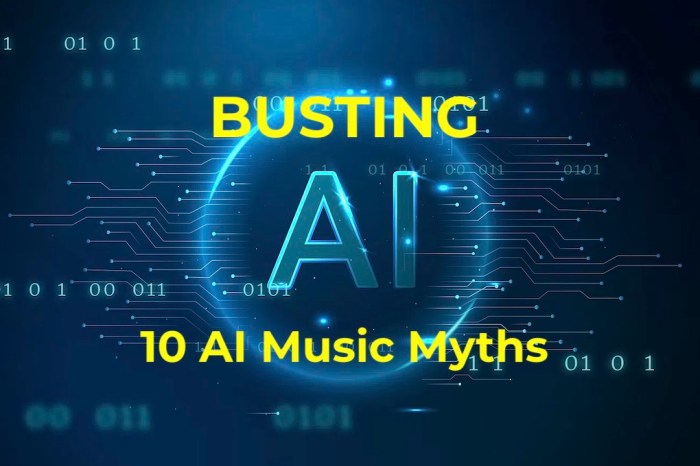
Who does AI help the most? This question delves into the multifaceted impact of Artificial Intelligence, exploring how it benefits various groups and industries. From revolutionizing healthcare to enhancing education, AI’s influence spans across diverse sectors, impacting individuals in unprecedented ways. The journey begins by examining the industries where AI has made the biggest difference, highlighting specific examples of its practical applications.
Beyond broad industry trends, we’ll explore specific use cases, examining how AI improves accessibility for underserved communities and people with disabilities. We’ll also examine the potential impact on different demographics, considering factors like age, socioeconomic status, and education level. Ultimately, we’ll assess the ethical considerations of AI adoption and its future trajectory, examining both the opportunities and risks involved.
Industries Benefiting Most
Artificial intelligence (AI) is rapidly transforming various industries, driving significant improvements in productivity, efficiency, and profitability. From automating repetitive tasks to enabling sophisticated data analysis, AI tools are revolutionizing how businesses operate and compete in the global marketplace. This shift is particularly noticeable in industries where data is abundant and complex processes are prevalent.
Key Industries Leveraging AI
AI is impacting numerous industries, and its adoption is accelerating. Several sectors are experiencing substantial benefits from AI integration, demonstrating a clear trend towards enhanced operations and greater profitability.
| Industry | Key AI Applications | Impact on Productivity/Efficiency/Profitability |
|---|---|---|
| Healthcare | AI-powered diagnostics, personalized medicine, drug discovery, robotic surgery, patient monitoring | Improved accuracy and speed of diagnoses, reduced medical errors, personalized treatment plans leading to better patient outcomes, increased efficiency in drug development, reduced costs through automation. |
| Finance | Fraud detection, risk assessment, algorithmic trading, customer service chatbots, personalized financial advice | Reduced fraud losses, improved risk management, increased trading profits, enhanced customer experience through 24/7 support, personalized financial planning for improved investment returns. |
| Retail | Personalized recommendations, inventory management, customer service chatbots, predictive analytics for demand forecasting | Increased sales through targeted recommendations, optimized inventory levels, improved customer service responsiveness, accurate demand forecasting leading to reduced waste and optimized stock levels. |
| Manufacturing | Predictive maintenance, quality control, automated assembly lines, supply chain optimization | Reduced equipment downtime, improved product quality, streamlined production processes, optimized supply chains reducing costs and lead times. |
| Transportation | Autonomous vehicles, route optimization, logistics management, predictive maintenance for vehicles | Enhanced safety and efficiency in transportation, optimized routes leading to reduced fuel consumption and time, improved logistics management for better delivery times, predictive maintenance minimizing downtime and costs. |
Comparing AI Adoption Across Sectors
Evaluating the level of AI adoption across various sectors is challenging due to the dynamic nature of technological advancements and varying reporting methodologies. However, certain sectors are demonstrating a higher level of integration, while others are still in the early stages of adopting AI technologies. A more comprehensive understanding of the rate of AI adoption requires detailed industry-specific analysis.
| Sector | Level of AI Adoption (Qualitative Assessment) |
|---|---|
| Finance | High |
| Healthcare | High |
| Retail | Medium |
| Manufacturing | Medium |
| Transportation | Medium-High |
| Agriculture | Low-Medium |
| Education | Low |
Specific Use Cases
AI’s transformative potential extends far beyond industry benchmarks. It’s impacting individuals in profound ways, offering solutions to longstanding challenges and opening new avenues for personal growth and well-being. This section delves into concrete examples of how AI is improving lives across diverse demographics.AI is no longer a futuristic concept; it’s actively shaping everyday interactions and experiences for countless individuals.
From personalized education to enhanced healthcare accessibility, AI is rapidly becoming an indispensable tool in various aspects of human life. This evolution presents opportunities for both progress and equity, particularly in underserved communities and for individuals with disabilities.
AI in Education
Educational institutions are leveraging AI to personalize learning experiences and tailor instruction to individual student needs. Adaptive learning platforms use AI algorithms to identify knowledge gaps and provide targeted practice exercises. This dynamic approach allows students to progress at their own pace, focusing on areas where they need extra support.For instance, AI-powered tutoring systems can provide instant feedback on assignments, identify patterns in student errors, and suggest personalized learning paths.
This proactive approach not only enhances comprehension but also fosters a more engaging and effective learning environment.
AI in Healthcare
AI’s impact on healthcare is multifaceted, ranging from early disease detection to personalized treatment plans. AI algorithms can analyze medical images (X-rays, MRIs) with remarkable accuracy, often detecting anomalies that might be missed by human eyes. This early detection can lead to timely intervention and improved patient outcomes.Furthermore, AI-driven tools can predict patient risk factors, personalize medication dosages, and even assist in drug discovery.
For example, AI algorithms are being trained to analyze patient data, including medical history, lifestyle factors, and genetic information, to create personalized treatment plans. This approach is crucial for managing chronic conditions and optimizing patient care.
AI in Social Services
AI is revolutionizing social services by automating tasks, streamlining processes, and providing targeted support. For instance, AI-powered chatbots can provide immediate responses to frequently asked questions from individuals needing social assistance, reducing wait times and improving accessibility.These chatbots can also help individuals navigate complex bureaucratic systems, ensuring that they have access to the resources they need. AI can also analyze social data to identify vulnerable populations and predict potential crises, enabling proactive interventions to mitigate negative outcomes.
Accessibility for People with Disabilities
AI is enhancing accessibility for individuals with disabilities in several impactful ways. Speech-to-text and text-to-speech software empowers individuals with communication challenges. For example, these tools facilitate seamless communication in various settings, from educational environments to professional workplaces.Similarly, AI-powered image captioning tools provide visual descriptions of images, making digital content more accessible to individuals with visual impairments. AI-driven assistive devices can also aid mobility and independent living, offering increased autonomy and control for individuals with physical limitations.
Table: AI Use Cases and Impact
| Use Case | Type of Tasks AI Performs | Impact on Beneficiaries |
|---|---|---|
| Education | Personalized learning paths, adaptive feedback, targeted practice exercises | Improved comprehension, increased engagement, personalized learning experiences |
| Healthcare | Medical image analysis, disease prediction, personalized treatment plans, drug discovery | Early disease detection, improved treatment outcomes, personalized care |
| Social Services | Automating tasks, streamlining processes, providing targeted support, analyzing social data | Reduced wait times, improved access to resources, proactive interventions |
| Accessibility | Speech-to-text, text-to-speech, image captioning, assistive devices | Enhanced communication, improved access to information, increased autonomy |
Impact on Different Demographics
AI’s transformative potential extends across all demographics, but its impact isn’t uniform. Understanding how AI affects different age groups, socioeconomic backgrounds, and education levels is crucial for ensuring equitable access to its benefits and mitigating potential harms. This examination explores the diverse ways AI is reshaping lives, highlighting potential disparities and opportunities.The application of AI across society isn’t a neutral process.
Its design, implementation, and use can unintentionally amplify existing inequalities or create new ones. Careful consideration of these potential consequences is paramount to ensuring that AI benefits all members of society, rather than exacerbating existing divides.
AI and Age Groups
The impact of AI varies significantly across age groups. Younger generations often embrace new technologies more readily, finding AI-powered tools useful for learning, communication, and entertainment. However, older generations may face challenges in adapting to AI-driven changes, potentially leading to social isolation or economic disruption. This disparity highlights the importance of tailored support systems for individuals of all ages to ensure a smooth transition into an AI-driven future.
AI and Socioeconomic Background
AI systems are increasingly used in areas like loan applications and hiring processes. While AI can automate these tasks and potentially reduce bias in human decision-making, the risk of perpetuating socioeconomic inequalities remains. Algorithms trained on biased historical data can perpetuate existing inequalities, disproportionately affecting individuals from lower socioeconomic backgrounds. For example, AI-powered loan applications might reject applicants from underserved communities due to biases embedded in the training data.
Addressing these concerns requires careful scrutiny of the data used to train AI systems and the development of robust fairness-focused algorithms.
AI and Education Levels
AI’s influence on education is multifaceted. For individuals with higher education, AI can provide personalized learning experiences and access to advanced research tools. However, those with limited educational opportunities might face a digital divide, further widening existing gaps. AI-powered educational tools could exacerbate existing inequalities if not designed and implemented with equity in mind.
AI-Training Biases and Demographics
AI systems are trained on vast datasets. If these datasets reflect existing societal biases, the AI systems will inherit and potentially amplify those biases. For instance, if a facial recognition system is trained primarily on images of light-skinned individuals, it may perform less accurately on images of people with darker skin tones. This is a critical issue across various applications, and mitigation strategies need to be incorporated into the design and development processes.
The development of AI systems that are fair and equitable requires careful consideration of the data used for training and the potential for bias amplification.
Potential Benefits and Risks of AI Adoption Across Demographics, Who does ai help the most
| Demographic Group | Potential Benefits | Potential Risks |
|---|---|---|
| Younger Generations | Enhanced learning experiences, personalized education, new career opportunities | Job displacement, social isolation, lack of critical thinking skills |
| Older Generations | Improved healthcare access, remote communication, reduced social isolation | Difficulty adapting to new technologies, potential for job displacement, financial insecurity |
| Lower Socioeconomic Backgrounds | Access to previously unavailable services, increased economic opportunities (potentially) | Exacerbation of existing inequalities, lack of access to resources needed to benefit, algorithmic bias |
| Individuals with Limited Education | Accessibility to learning resources, personalized learning paths | Digital divide, potential for widening skill gaps, lack of training opportunities |
Accessibility and Affordability
AI’s transformative potential is hampered if its tools remain inaccessible to many. Cost and complexity are major barriers, preventing equitable participation in the AI revolution. Bridging this digital divide is crucial to unlocking AI’s full potential for societal benefit. Addressing affordability and accessibility ensures that the advantages of AI are not limited to a select few.The economic and social ramifications of unequal AI access are significant.
Excluding certain demographics from AI-powered services can exacerbate existing inequalities, potentially widening the gap between those who benefit from the technology and those who are left behind. This issue demands proactive solutions to ensure a more inclusive and equitable future.
Factors Affecting Accessibility
Several factors contribute to the varying degrees of accessibility to AI tools. Technical complexity, requiring specialized knowledge and skills, is a significant hurdle. Furthermore, the high initial investment costs for hardware, software, and training can pose a considerable barrier, especially for smaller businesses and individuals. The digital divide, characterized by unequal access to reliable internet connectivity and computing power, further complicates matters.
Affordability Challenges
The costs associated with AI implementation vary significantly. For example, developing and deploying a custom AI model for a specific business process can involve substantial upfront expenses. Maintenance and ongoing support costs are also crucial considerations. Small businesses and individuals may struggle to afford these expenses, potentially limiting their participation in the AI economy.
AI’s benefits often disproportionately favor large corporations and governments, but it’s also clear that smaller businesses and individuals can greatly benefit too. While the recent clashes between Trump and Musk over SpaceX and NASA’s role in space exploration ( trump musk feud spacex nasa ) highlight a different kind of technological advancement, AI’s real-world applications ultimately help those who can leverage it best, whether they’re a global powerhouse or a local entrepreneur.
Government Policies and Initiatives
Government policies play a crucial role in promoting AI adoption and reducing disparities. Subsidies for AI training and development, tax breaks for AI startups, and accessible funding programs can help democratize access to the technology. Moreover, promoting public-private partnerships can facilitate the development and distribution of affordable AI tools. Furthermore, clear and comprehensive regulations on data privacy and security are essential to encourage broader adoption and trust.
Levels of AI Adoption Costs
| Level of AI Adoption | Cost Range | Impact on User Groups |
|---|---|---|
| Basic AI tools (e.g., chatbots, image recognition APIs) | Low to moderate | Individuals, small businesses, and non-profits can readily adopt these tools. |
| Custom AI model development | Moderate to high | Larger businesses and organizations with significant resources are likely to invest in this level of adoption. |
| Advanced AI infrastructure (e.g., cloud-based AI platforms) | High | Only large enterprises with substantial budgets are likely to invest in this level. |
This table highlights the diverse cost structures associated with AI adoption. The cost varies significantly based on the complexity and scope of the AI implementation.
Ensuring Equitable Access
Promoting equitable access to AI technologies requires a multi-faceted approach. This includes making AI tools more user-friendly and accessible through intuitive interfaces and simplified training materials. Additionally, developing affordable AI solutions tailored to specific needs, like those in the developing world, is critical. Educational initiatives that equip individuals with the necessary AI skills can also significantly contribute to broader participation.
AI’s benefits often seem concentrated in high-tech industries, but it’s fascinating how it can also impact less obvious areas. For example, recent events like the trump marines la immigration protests could potentially be analyzed using AI to identify patterns and predict future scenarios. Ultimately, AI’s potential to assist in understanding complex situations, like those relating to immigration, means it could potentially benefit everyone, not just the wealthy or powerful.
Furthermore, fostering open-source AI projects and promoting collaborative research initiatives can democratize access to AI technologies and facilitate their wider adoption.
AI’s Role in Education and Skill Development

AI is rapidly transforming the educational landscape, promising to personalize learning experiences and equip students with the skills needed for the future. From automated grading to personalized learning pathways, AI offers the potential to revolutionize how we teach and learn. This shift necessitates a careful consideration of the ethical implications and the need for equitable access to these advancements.AI-powered tools can adapt to individual learning styles, pace, and needs, creating a more dynamic and effective learning environment.
This tailored approach can lead to increased engagement and improved learning outcomes for students. By leveraging data analytics and machine learning, AI systems can identify knowledge gaps and provide targeted support, ultimately fostering a deeper understanding of concepts.
Personalized Learning Experiences
AI can create truly personalized learning experiences by analyzing student performance data to tailor content and pace. Adaptive learning platforms adjust difficulty levels and content delivery based on individual student progress, ensuring a more effective and engaging learning journey. This individualized approach allows students to learn at their own speed and focus on areas where they need more support.
For example, AI-powered tutoring systems can identify specific weaknesses in a student’s understanding of a subject and provide targeted practice exercises, leading to a more effective learning outcome.
AI-Powered Tools for Skill Development
AI can significantly enhance skill development by providing personalized practice and feedback. Interactive simulations and virtual labs can expose students to real-world scenarios, allowing them to develop crucial skills like problem-solving and critical thinking. This hands-on experience can be particularly valuable for complex or technical fields. Moreover, AI-powered tools can analyze student work and provide detailed feedback, helping students refine their skills and improve their understanding.
Ethical Considerations of AI in Education
The use of AI in education raises important ethical considerations, including potential biases in algorithms and the equitable access to AI-powered tools. Ensuring fairness and preventing bias in AI algorithms is crucial. For example, algorithms trained on historical data might reflect existing societal biases, potentially perpetuating inequalities in educational opportunities. Therefore, careful consideration and rigorous testing of AI systems are necessary to minimize these risks and promote equitable access to quality education for all students.
Supporting Diverse Learning Styles and Needs
AI can support diverse learning styles and needs in various ways. For example, AI-powered tools can translate content into different languages, making learning materials accessible to students from diverse linguistic backgrounds. Furthermore, AI can adapt to different learning styles, providing interactive exercises and engaging multimedia content to cater to visual, auditory, and kinesthetic learners. Additionally, AI-powered tools can provide real-time support to students with disabilities, ensuring they have equal access to learning opportunities.
- Language Accessibility: AI tools can translate content into various languages, making learning materials accessible to a wider range of students.
- Visual Learning: Interactive simulations and visual aids enhance understanding for visual learners.
- Auditory Learning: Audio-based learning materials can cater to auditory learners.
- Kinesthetic Learning: Hands-on activities and interactive simulations support kinesthetic learners.
- Learning Disabilities: AI can provide personalized support for students with disabilities, ensuring equal access to learning opportunities.
AI in Healthcare and Well-being
Artificial intelligence (AI) is rapidly transforming healthcare, promising to enhance patient care, improve diagnostics, and personalize treatment plans. From automating administrative tasks to assisting in complex surgeries, AI’s potential in healthcare is vast and multifaceted. This transformation is not just about efficiency; it’s about improving the quality of life for patients and healthcare professionals alike.AI is revolutionizing healthcare by leveraging vast datasets to analyze patient information, predict potential health risks, and ultimately deliver more effective and personalized care.
This technology is enabling a shift from reactive to proactive healthcare, empowering individuals to take control of their well-being and contributing to a healthier global population.
AI in Diagnostics
AI algorithms are proving remarkably adept at analyzing medical images, such as X-rays, CT scans, and MRIs, to detect anomalies and potential diseases with remarkable accuracy. These algorithms can identify patterns and abnormalities that might be missed by the human eye, leading to earlier diagnoses and improved treatment outcomes. Early detection, in particular, is critical for conditions like cancer, where timely intervention significantly increases the chances of successful treatment.
AI in Treatment Planning
AI tools can assist healthcare professionals in developing personalized treatment plans by considering individual patient factors such as genetic makeup, medical history, and lifestyle choices. This personalized approach leads to more effective and tailored interventions, minimizing side effects and maximizing treatment efficacy.
AI-Powered Patient Monitoring
AI tools are being developed to continuously monitor patients’ vital signs and health data, allowing for early detection of potential complications and enabling proactive interventions. This technology is especially valuable for chronic disease management, allowing patients to actively participate in their own care and stay informed about their health. For example, wearable devices equipped with AI can track heart rate, sleep patterns, and activity levels, providing valuable insights into a patient’s overall health and potentially identifying emerging trends.
AI in Administrative Tasks
AI is streamlining administrative tasks in healthcare settings, such as scheduling appointments, managing patient records, and processing insurance claims. This automation frees up healthcare professionals to focus on patient care, leading to improved efficiency and reduced administrative burden. By automating these tasks, AI also reduces the potential for errors and improves the accuracy of patient data management. For example, AI-powered systems can automatically schedule appointments based on patient availability and provider schedules, optimizing clinic workflows.
Examples of AI-Powered Health Tools
- AI-driven diagnostic tools: These tools analyze medical images to detect diseases like cancer, cardiovascular issues, and eye problems, potentially improving diagnostic accuracy and speed. For example, AI-powered systems can identify subtle abnormalities in mammograms that might be missed by radiologists, potentially saving lives through earlier detection of breast cancer.
- Personalized treatment recommendations: AI algorithms can analyze patient data to suggest personalized treatment plans, optimizing treatment outcomes and reducing adverse effects. This is especially valuable in oncology, where AI can help tailor chemotherapy regimens to individual patient needs.
- Virtual assistants for patients: AI-powered virtual assistants can provide patients with personalized health information, reminders for appointments, and support in managing their health conditions. These assistants can also provide access to relevant medical resources and information, empowering patients to take an active role in their care.
Ethical Considerations

Artificial intelligence (AI) is rapidly transforming various aspects of our lives, offering immense potential for progress. However, with this potential comes a crucial need for careful consideration of the ethical implications of AI adoption. This section delves into the complex ethical landscape surrounding AI, exploring the potential risks, biases, and the importance of responsible development and deployment. Navigating these challenges is paramount to ensuring that AI benefits all of humanity.The ethical considerations surrounding AI extend beyond simple technical implementation.
They involve fundamental questions about fairness, transparency, accountability, and the very nature of human interaction with increasingly sophisticated technologies. We must proactively address these ethical concerns to harness AI’s potential while mitigating its risks.
AI, in its various forms, often helps those with the most complex problems. Think about how AI could potentially analyze massive datasets of crime scene evidence, like in the recent “Murderland” Caroline Fraser interview about serial killers, and lead to new theories. murderland caroline fraser interview serial killers lead theory This could ultimately benefit law enforcement and justice systems by potentially accelerating investigations and solving cases.
Ultimately, AI’s potential impact on solving crimes like these highlights its power to help those needing assistance the most.
Potential Risks and Biases
AI systems are trained on data, and if that data reflects existing societal biases, the AI will likely perpetuate and even amplify them. This can lead to discriminatory outcomes in areas like loan applications, hiring processes, or even criminal justice. For instance, an AI trained on historical data that reflects gender bias might perpetuate that bias in its decision-making.
This underscores the critical need for diverse and representative datasets to mitigate these biases.
Importance of Responsible AI Development
Responsible AI development necessitates a multi-faceted approach encompassing the entire lifecycle of an AI system. This includes careful data selection and preprocessing, rigorous testing for bias, and ongoing monitoring for unintended consequences. Furthermore, clear guidelines and regulations are needed to ensure transparency and accountability in AI systems. Companies and organizations must prioritize ethical considerations throughout the AI development process.
Accountability and Transparency
Ensuring accountability and transparency in AI systems is crucial. Understanding how AI systems arrive at their decisions is essential for identifying and rectifying potential biases or errors. Robust mechanisms for auditing AI systems are needed to ensure that they are operating as intended and are not perpetuating harmful societal biases.
Fairness and Equity
AI systems should strive for fairness and equity in their applications. Disparities in access to AI technologies and services could exacerbate existing societal inequalities. This requires careful consideration of how AI systems are designed, deployed, and regulated to ensure equitable access and outcomes for all.
Data Privacy and Security
The collection and use of data by AI systems raise significant privacy and security concerns. Protecting personal data and ensuring its responsible use is paramount to maintaining trust and preventing misuse. Strong data protection regulations and ethical guidelines are essential to safeguard user privacy in the age of AI.
Table of Ethical Considerations
| Ethical Consideration | Examples | Discussion Points |
|---|---|---|
| Bias | Facial recognition software misidentifying people of color, loan applications unfairly rejecting applications from certain demographics | Data sources, algorithm design, testing procedures, ongoing monitoring for biases |
| Transparency | Lack of explainability in AI-driven decision-making, opacity in algorithmic processes | Documentation of data and algorithms, user-friendly explanations, clear communication of limitations |
| Accountability | Difficulty assigning responsibility for errors or harm caused by AI systems, lack of clear legal frameworks | Identification of responsible parties, standards for AI system development, regulatory oversight |
| Fairness | Unequal access to AI-powered tools, differential impact on various social groups | Equity in access, unbiased algorithm design, careful consideration of impact on diverse populations |
| Privacy | Collection and use of personal data without informed consent, potential for data breaches | Data minimization, informed consent protocols, robust data security measures |
Future Trends and Predictions: Who Does Ai Help The Most
The rapid advancement of AI is reshaping industries and daily life. Predicting the precise future is impossible, but by examining current trends, we can glimpse potential trajectories. This exploration delves into anticipated impacts across sectors, emerging technologies, and potential challenges, providing a framework for understanding the evolving role of AI in our world.The pace of AI innovation is accelerating, driven by increased computational power, readily available data, and sophisticated algorithms.
This dynamic environment necessitates a forward-looking approach to understanding the potential consequences and opportunities that arise.
Potential Impacts on Various Sectors
AI is poised to transform numerous sectors, impacting everything from manufacturing to healthcare. The following are potential examples of these impacts.
- Manufacturing and Automation: AI-powered robots and systems are expected to enhance efficiency, reduce costs, and improve product quality. Companies like Tesla are already utilizing AI to optimize production lines and improve the safety and efficiency of their factories. Predictive maintenance powered by AI can reduce downtime and minimize costly equipment failures.
- Healthcare: AI is revolutionizing diagnostics, drug discovery, and personalized medicine. Improved diagnostic tools can detect diseases earlier, leading to better treatment outcomes. AI algorithms can analyze medical images, identify patterns, and aid in the diagnosis of various conditions. This also includes AI-driven tools for personalized medicine, tailoring treatment plans to individual patient needs based on genetic information and other factors.
- Finance: AI is expected to play a significant role in fraud detection, risk assessment, and investment strategies. Sophisticated algorithms can analyze vast amounts of financial data to identify patterns and anomalies, which is useful for fraud prevention and customer risk profiling. AI-powered trading algorithms can potentially optimize investment strategies and portfolio management.
Emerging Trends in AI
Several emerging trends in AI are shaping its future. These trends include advancements in specific areas and general improvements in AI capabilities.
- Generative AI: Generative AI models are creating remarkable outputs, from generating realistic images and text to composing music. This technology has the potential to transform creative industries, impacting content creation, art, and design.
- Explainable AI (XAI): The need for transparency and understanding in AI decision-making is growing. XAI aims to make AI systems more understandable, promoting trust and responsible use.
- Edge AI: Processing data closer to the source, rather than sending it to a central server, is becoming increasingly important. Edge AI can enable faster and more responsive applications, reducing latency and improving efficiency, particularly in IoT devices and robotics.
Potential Future Challenges and Opportunities
The widespread adoption of AI presents both challenges and opportunities.
- Job Displacement: Automation driven by AI may lead to job displacement in certain sectors. However, AI also creates new jobs in areas such as AI development, maintenance, and ethical considerations.
- Ethical Concerns: Bias in AI algorithms, privacy concerns, and the potential for misuse are important ethical considerations that must be addressed. These concerns need to be addressed through responsible development and implementation strategies.
- Data Security: Protecting the vast amounts of data used to train and operate AI systems is paramount. Robust security measures are crucial to safeguard sensitive information and prevent breaches.
Detailed Presentation Artikel: The Future of AI
This presentation will provide a comprehensive overview of the future of AI, examining its transformative potential and associated challenges.
| Section | Content |
|---|---|
| Introduction | Overview of AI’s current state and rapid evolution |
| Potential Impacts | Analysis of AI’s influence across various sectors, including healthcare, finance, and manufacturing |
| Emerging Trends | Exploration of generative AI, XAI, and edge AI, including examples and implications |
| Challenges and Opportunities | Discussion of job displacement, ethical concerns, and data security issues, along with potential solutions and opportunities |
| Conclusion | Summary of key takeaways and future outlook |
Final Conclusion
In conclusion, AI’s impact on society is profound and multifaceted. While offering tremendous potential to enhance productivity, efficiency, and accessibility, the equitable distribution of AI’s benefits remains a crucial consideration. Understanding the diverse ways AI affects different demographics and industries is key to ensuring its responsible and beneficial deployment for all.







